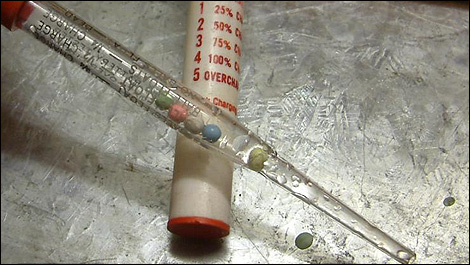Operation and user tipsA battery combines two different metals called electrodes. The latter bathe in electrolyte, meaning any substance containing free ions that behaves as an electrically conductive medium. The current is produced through electrolysis or oxidoreduction. A positive charge is given to the "+" electrode (cathode).
That's why it's very important that your battery is properly connected, with the red cable always on the positive electrode. When disconnecting a battery, always retrieve the black cable (negative) first -- and reconnect it last. This way, you'll avoid short circuits. By the way, the negative electrode is called anode.
Battery discharge is the result of a chemical reaction between the electrolyte and electrodes. In a traditional battery, a complete discharge means the only thing left around the plates is water (no more acid). Obviously, I won't list the various formulas that come into effect during this chemical phenomenon.
 |
| The battery hydrometer can check the state of charge a battery. |
As the name implies, a discharge happens when the energy stored in the battery is used to charge another component. If you forget to switch the ignition off at the end of your ride, or if the power accessories on your motorcycle consume too much energy for the alternator to handle, the battery charge won't last very long. Expect ignition failures or a sudden breakdown.
Extreme temperatures also affect batteries. During winter, your battery will be limited to 40-60 percent of its total capacity. The same thing happens come hot summer days. The amount of electrolyte in the battery pack will substantially decrease due to water evaporation in the cells. One solution is to add distilled or ionized water. Ionized water is by far the better choice since it comes free of contaminating residues.
No-maintenance battery packs are a whole different story. They use metallurgical materials that prevent water decomposition during overcurrent situations and extend the battery's lifecycle. Of course, they're priced accordingly -- up to three times the cost of a regular battery.
Charging a batteryBefore you start charging a battery pack, you
have to determine the state of charge by using a voltmeter. Put the red
wire on the positive electrode and the black wire on the negative
electrode. The result should be at least 12.8 volts for a regular
battery and 13 volts for a no-maintenance battery.
Use a
charger limited at 1.2 amp-hour. If you plan on storing your motorcycle
for 3 to 6 months, a slow charger is preferable (under 0.5 amp-hour).
It can stay connected at all times, provided that it includes
overcurrent protection. In fact, my advice to you is to always use a
charger with overcurrent protection.
Photo Credit : Henri Lebarbé

